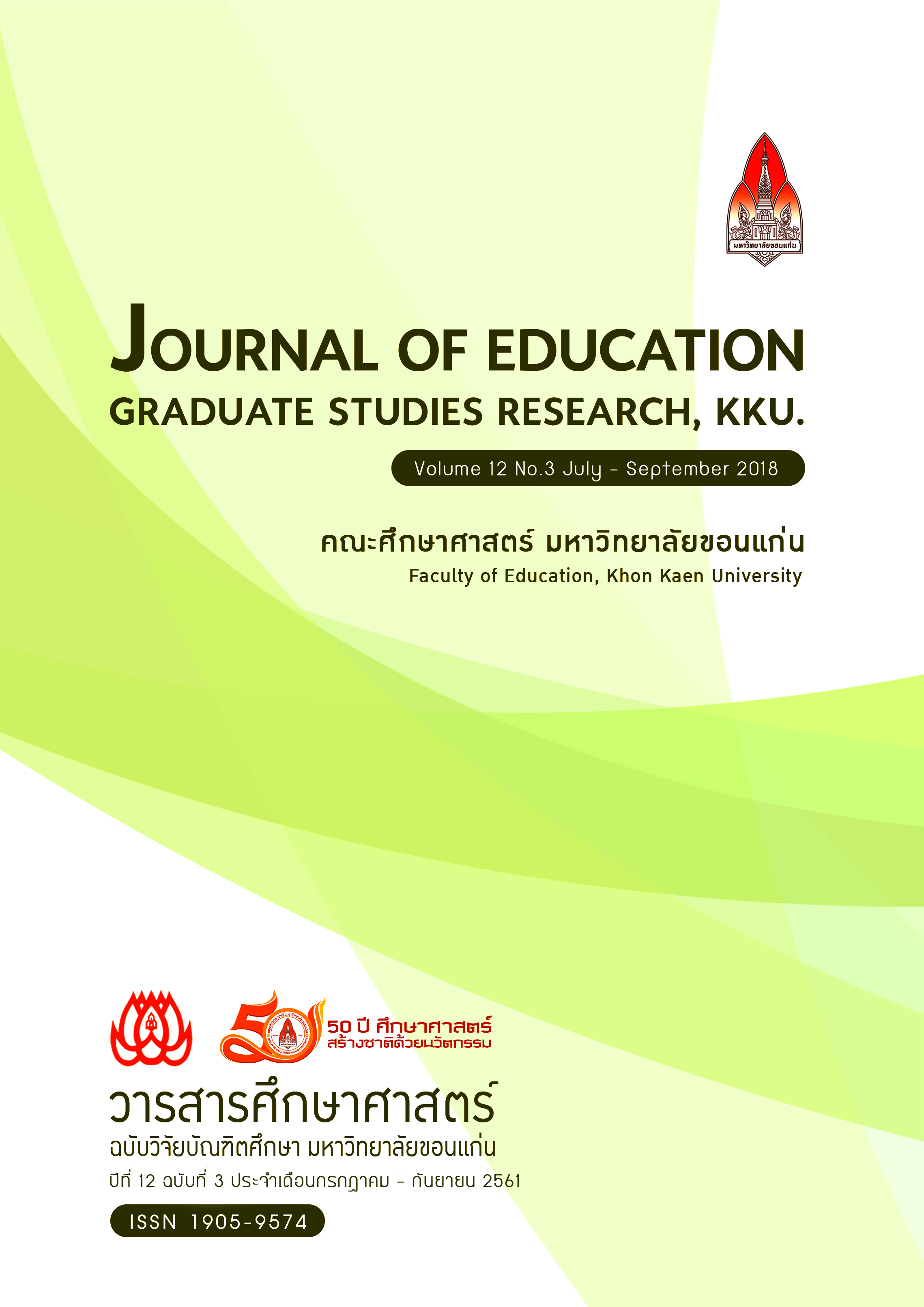Developing Grade 5 Students’ Mathematical Problem Solving Ability Using CIPPA Learning Model Together with Graphic Mapping
Main Article Content
Abstract
The objectives of the present study included: 1) to develop grade-5 students’ mathematical problem-solving ability by using CIPPA Learning Model together with graphic mapping so that the students made a mean achievement score of 70% or higher and at least 70% of the student group pass the prescribed criterion and 2) to study the students’ satisfaction with the learning activities basing on the CIPPA Learning Model together with the graphic mapping. The target group consisted of 10 grade-5 students in Ban Lao Noenkoon School under the Khon Kaen Office of Primary Education, Area 3, during the first semester of the 2015 academic year. The study was based on an action research procedure in accordance with Kemmis & McTaggart’s idea which consists of 3 action spirals. Three categories of instruments were used in the study, i.e. 1) action research tool consisting of 8 lesson plans which took 16 instructional periods to complete, 2) reflection tool consisting of a teaching behavior observation form,
a student behavior observation form, Instruction records form, a student interview form and end-of-spiral quizzes on the students’ mathematical problem-solving ability, and 3) evaluation tool consisting of
a 5-item test for the assessment of the students’ mathematical problems solving ability and a 15-item questionnaire, with a 5-level rating scale, for making inquiries about the students’ satisfaction with the learning activities as organized for them. The collected data were analyzed by means of basic statistics of arithmetic mean, standard deviation, and percentage, while the qualitative data were analyzed by means of content analysis.
The findings:
- The students made a mean achievement score of 45.90 or 76.50% of the full marks in the mathematical problem-solving ability, and 8 students or 80% of the group passed the 70% criterion which is higher than the prescribed criterion of 70%;
- The students’ level of satisfaction with the learning activities, as a whole, was at the “highest” level ( x̄ = 4.54, S.D. = 0.46 ). However, when the items were scrutinized categorically, it was found that the item on “The activities that encourage the student to show off freely” made the highest mean score ( x̄ = 4.82, S.D. = 0.39 ). The second significant item was “The activities that allow the students to do the actual practice” ( x̄ = 4.77, S.D. = 0.44 ) and “Students review their knowledge and understanding of new content” ( = 4.71, S.D. = 0.47 )
Article Details
References
กระทรวงศึกษาธิการ . (2551). หลักสูตรแกนกลางการศึกษาขั้นพื้นฐาน พุทธศักราช 2551. กรุงเทพฯ: ชุมนุมสหกรณ์การเกษตรแห่งประเทศไทย.
กรรณิการ์ อ่าท้าว. (2555). การพัฒนากิจกรรมการเรียนรู้คณิตศาสตร์โดยใช้โมเดลซิปปา เรื่อง การแก้โจทย์ปัญหาการบวก ลบ คูณ หาร ของนักเรียนชั้นประถมศึกษาปีที่ 3. วิทยานิพนธ์ศึกษาศาสตรมหาบัณฑิต สาขาวิชาหลักสูตรและการสอน บัณฑิตวิทยาลัย มหาวิทยาลัยขอนแก่น.
ฐาศิริ ไชยลึก. (2552). ผลการใช้รูปแบบซิปปาร่วมกับเทคนิคการใช้ผังกราฟิกตอการคิดเชิงมโนทัศน์การเขียนภาษาไทยเชิงสร้างสรรค์ของนักเรียนชั้นประถมศึกษาปีที่ 4. วารสารหลักและการสอนทักษิณ, 4(1), 53-60.
ทิศนา แขมมณี. (2550). ศาสตร์การสอน: องค์ความรู้เพื่อการจัดกระบวนการเรียนรู้ที่มีประสิทธิภาพ. พิมพ์ครั้งที่ 5. กรุงเทพฯ: จุฬาลงกรณ์มหาวิทยาลัย.
ทิศนา แขมมณี. (2555). ศาสตร์การสอน: องค์ความรู้เพื่อการจัดกระบวนการเรียนรู้ที่มีประสิทธิภาพ. พิมพ์ครั้งที่ 16. กรุงเทพฯ: จุฬาลงกรณ์มหาวิทยาลัย.
บุญชม ศรีสะอาด. (2545). การวิจัยเบื้องต้น (ฉบับปรับปรุงใหม่). พิมพ์ครั้งที่ 7. กรุงเทพฯ: สุวีริยาสาส์น.
ปรีชา เนาว์เย็นผล. (2538). การแก้โจทย์ปัญหาคณิตศาสตร์. กรุงเทพฯ: จุฬาลงกรณ์มหาวิทยาลัย.
ปอเรียม แสงชาลี. (2549). ผลการเรียนเรื่องเส้นขนาน โดยใช้การจัดกิจกรรมการเรียนรู้ตามรูปแบบซิปปา (CIPPA Model) และกิจกรรมการเรียนรู้ตามรูปแบบของ สสวท. ที่มีผลต่อการเรียนรู้ของนักเรียนชั้นมัธยมศึกษาปีที่ 2. วิทยานิพนธ์การศึกษามหาบัณฑิต สาขาวิชาหลักสูตรและการสอน บัณฑิตวิทยาลัย มหาวิทยาลัยมหาสารคาม.
พิมพ์พันธ์ เดชะคุปต์. (2544). การเรียนการสอนที่เน้นผู้เรียนเป็นสำคัญ: แนวคิดวิธีและเทคนิคการสอน. กรุงเทพฯ: เดอะมาสเตอร์กรุฟแมนเนจเม้นท์.
ภาวิช ทองโรจน์. (2551). แก้ไขปัญหาการศึกษาของชาติ. สืบค้นเมื่อวันที่ 4 พฤษภาคม 2558, จากhttps://www.facebook.com/cheerpavich? fref=nf.
ยาใจ พงษ์บริบูรณ์. (2537). การวิจัยเพื่อพัฒนาการเรียนการสอน. ขอนแก่น: บัณฑิตวิทยาลัย มหาวิทยาลัยขอนแก่น.
เรณู ไม้แก่น. (2550). การเปรียบเทียบผลสัมฤทธิ์และเจตคติต่อการเรียนกลุ่มสาระการเรียนรู้คณิตศาสตร์ เรื่อง โจทย์ปัญหาร้อยละ ของนักเรียนชั้นประถมศึกษาปีที่ 6 ที่ได้รับการสอนโดยรูปแบบการสอนผังกราฟิกกับการสอนแบบปกติ. วิทยานิพนธ์ครุศาสตร์มหาบัณฑิต สาขาวิชาหลักสูตรและการสอน บัณฑิตวิทยาลัย มหาวิทยาลัยราชภัฏเทพสตรี.
โรงเรียนบ้านเหล่าโนนคูณ. (2558). การทดสอบทางการศึกษาระดับชาติขั้นพื้นฐาน (O-NET) ในกลุ่มสาระการเรียนรู้คณิตศาสตร์ระดับชั้นประถมศึกษาปีที่ 6. ขอนแก่น: กลุ่มบริหารวิชาการ โรงเรียนบ้านเหล่าโนนคูณ.
ล้วน สายยศ และ อังคณา สายยศ. (2538). เทคนิคการวิจัยทางการศึกษา. กรุงเทพฯ: สุวีริยาสาส์น.
สถาบันส่งเสริมการสอนวิทยาศาสตร์และเทคโนโลยี. (2558). เด็กไทยอ่อนคณิตศาสตร์. ค้นเมื่อ 28 เมษายน 2558, จากhttp://www.sensemath.com/.
สมเดช บุญประจักษ์. (2540). การพัฒนาศักยภาพทางคณิตศาสตร์ของนักเรียนชั้นมัธยมศึกษา ปีที่ 1 โดยการใช้การเรียนแบบร่วมมือ. วิทยานิพนธ์การศึกษาดุษฎีบัณฑิต สาขาวิชาคณิตศาสตร์ศึกษา บัณฑิตวิทยาลัย มหาวิทยาลัยศรีนครินทรวิโรฒ.
สมพงษ์ ปั้นหุ่น. (2552). การพัฒนาแบบตรวจสอบรายการประเมินแบบเสริมพลังอำนาจ เพื่อพัฒนาทักษะการประเมินของครูและนักเรียน. วิทยานิพนธ์การศึกษาดุษฎีบัณฑิต สาขาวิชาการวัดและประเมินผลการศึกษา บัณฑิตวิทยาลัย จุฬาลงกรณ์มหาวิทยาลัย.
สิริพร ทิพย์คง. (2545). หนังสือประสบการณ์วิชาคณิตศาสตร์ระดับประถมศึกษา“เรื่องการแก้ปัญหาคณิตศาสตร์. กรุงเทพฯ: กระทรวงศึกษาธิการ.
Beyer, K. B. (1997). Improving Student Thinking: A Comprehensive Approach. CA: Allyn and Bacon.
Clarke, John H. (1991). Using Visual Organizers to Focus on Thinking. Journal of Reading, 34(7), 526-534.
Dwight Waldo. (1984). The administrative state: study of the political theory of merican public administration. New York: The Ronald Press Company.
Hughes, Faya Noreen. (2005). The effects of utilizing graphic organizers with traditional basal reading instruction on sixth – grade reading comprehension achievement scores. New Jersey: Prentice Hall.
Molefe, J. K. (2004). Challenging student though mathematics: A culturally relevant problem – solving. Abstract from: ProQuest File: Dissertation Abstracts International Item

